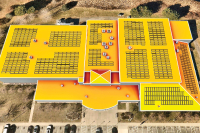Rare mountain tornado damages GSMNP
The National Weather Service has confirmed that a tornado formed during an afternoon of thunderstorms and high winds that ripped through Western North Carolina two weeks ago.
The tornado touched down briefly in a portion of the Great Smoky Mountains National Park in Haywood County, making its mark as only the second confirmed tornado in the mountainous county in more than half a century.
According to the Greenville-Spartanburg National Weather Service, the tornado occurred at 4:10 p.m. June 13 in the Big Creek area of the park. Although the tornado only occurred for about 10 minutes, its winds reached speeds of 100 miles per hour as it carved a football field-sized swath of downed trees and debris through the forest.
“It snapped a bunch of trees and uprooted a bunch of trees along the trails,” said National Weather Service Meteorologist Scott Krentz.
The tornado was part of a larger storm front that moved across the region that day. Winds left sections of the park impassable and caused closures at one campground.
Related Items
A tornado warning was issued for Haywood County as the storm gained speed. However, the tornado could not be confirmed until weather service professionals were able to arrive at the scene last week and confirm by the wreckage that it had indeed reached ground level — a prerequisite to be considered a legitimate tornado and not just a funnel cloud. Trees snapped off 20 feet in the air and trunks lying in opposite directions on either side of the tornado’s center are tell-tale signs of a twister.
Park officials are still surveying the damage. One man was injured in that storm by a falling tree and transported to Mission Hospital in Asheville.
On the day of the storm, most residents were caught off guard by the tornado warning — a rarity in most mountainous regions. Peaks and ridges tend to act as a roadblock for the stream of moist, warm air from the Caribbean that feeds tornado-causing storms as it clashes with drier and cooler air from the north and southwest.
“It’s not real common at all,” said Krentz, who is based in South Carolina. “Usually when they reach a higher terrain, they get disrupted, but this storm was pretty strong.”
The tornado was ranked as an EF-1, the weakest classification, but its wind speeds were only a few notches away from putting it in the EF-2 category. The last tornado confirmed tornado in Haywood County came in 1976 near Lake Junaluska and was also an EF-1.
In general, WNC counties rarely see any tornados at all. Since the 1950s, Swain County has had two; Jackson County has had three; and Macon County has seen four. Meanwhile, several eastern counties had two to three tornados just in 2012.
On that afternoon in Waynesville, after the warning was issued, groups of people were still meandering around the downtown area as the rain cleared. Others questioned if the warning was real.
The number of residents in Buncombe and Haywood counties who went running for an interior room without windows or the basement is unknown, but local meteorologist David Still with Ray’s Weather guesses the number was near to nil. Most people, he said, don’t follow the tornado preparedness textbook, especially those in the mountains who have probably never been through a tornado warning their entire lives.
“It just kind of goes to show that it’s easy to forget in the mountains that tornados can happen because they’re so rare,” Still said. “Folks in Haywood County and Buncombe County probably didn’t do a darn thing.”
However, Still, who previously worked as a weatherman in the prime twister territory of Iowa, said he saw the same reaction there. The Internet abounds with Youtube videos where residents can be seen on their front porches looking to catch a glimpse of the incoming tornado. And reports such as the 1987 high-elevation F4 tornado that cut a 25-mile path through Wyoming and crossed the continental divide at 10,000 feet make Still nervous when mountain residents don’t take warnings seriously.
“They’re pretty narrow so everyone thinks it’s not going to hit them,” Still said. “That’s just human nature.”
The state of North Carolina has never seen an EF-5, which has wind speeds of more than 200 miles per hour. But the mountains and the forested terrain in the state can actually make a less powerful tornado more dangerous. People don’t have time to spot it and move to a safe place.
On the Great Plains or in the Midwest, tornados can be seen up to 20 miles away. In WNC, most storms with tornado potential enter from Tennessee or Georgia and dissipate over the mountains — a reason the state doesn’t have many prolonged thunderstorms either.
The storms that do maintain the energy to become a funnel cloud and then a tornado have the potential to cause damage to the unsuspecting WNC resident.
“The few storms we do get here can be very dangerous,” said Ryan Boyles, director of state climate office. “By the time they’re visually confirmed, they’re generally right on top of you.”









